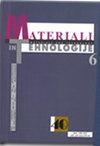SYNTHESIS OF CALCIUM SILICATE MATERIALS FROM THE RESIDUAL WASTE SLUDGE OF A WATER-PURIFICATION PLANT
IF 0.6
4区 材料科学
Q4 MATERIALS SCIENCE, MULTIDISCIPLINARY
引用次数: 0
Abstract
Calcium silicate is produced from a mixture of silica sand powder, lime, paper pulp, and Portland cement hydrothermally steamed at 180 °C for about 16 h. This material is considered environmentally friendly and is popular in countries around the world. In this study, quartz sand was replaced with residual waste sludge from water-filtration plants to produce calcium silicate materials. Nowadays, the residual waste sludge from water-filtration plants is an environmental problem that needs to be treated. The results of determining the properties showed that a sample using 10 w/% residual waste sludge gave the best replacement. This sample had a bending strength of 10.95 MPa, a volumetric density of 1.57 g/cm3, and water absorption of 23.67 %. The results of the analysis of the mineral composition (by X-ray diffraction analysis and Fourier-transform infrared spectroscopy) and microstructure (by scanning electron microscopy) showed that all samples formed tobermorite and xonotlite minerals. The tobermorite and the xonotlite are hydro-silicate-calcium minerals characteristic of calcium silicate materials, which are the synthesis products of chemical reactions of SiO2, CaO, and H2O under hydrothermal conditions. Samples using 5–10 w/% of waste residual sludge have even higher mechanical strength than samples without. Therefore, using waste residual sludge from water-filtration plants to replace part of the sand in producing calcium silicate materials can be considered an effective method to treat environmental problems caused by waste residual sludge.利用净水厂剩余废渣合成硅酸钙材料
硅酸钙是由硅砂粉、石灰、纸浆和硅酸盐水泥的混合物在 180 °C 下水力蒸煮约 16 小时而制成的。在这项研究中,石英砂被滤水厂的残余废渣取代,用于生产硅酸钙材料。如今,滤水厂的残余废渣已成为需要处理的环境问题。性能测定结果表明,使用 10 w/% 剩余污泥的样品具有最佳的替代性。该样品的抗弯强度为 10.95 兆帕,体积密度为 1.57 克/立方厘米,吸水率为 23.67%。矿物成分分析(通过 X 射线衍射分析和傅立叶变换红外光谱分析)和微观结构分析(通过扫描电子显微镜)的结果表明,所有样品都形成了托勃莫来石和黝帘石矿物。托贝莫来石和黝帘石是硅酸钙材料特有的水硅钙矿物,是 SiO2、CaO 和 H2O 在水热条件下发生化学反应的合成产物。使用 5-10 w/% 废渣污泥的样品比不使用废渣污泥的样品具有更高的机械强度。因此,在生产硅酸钙材料的过程中,利用滤水厂的废渣代替部分沙子,可以说是解决废渣所造成的环境问题的一种有效方法。
本文章由计算机程序翻译,如有差异,请以英文原文为准。
求助全文
约1分钟内获得全文
求助全文
来源期刊

Materiali in tehnologije
工程技术-材料科学:综合
CiteScore
1.30
自引率
0.00%
发文量
73
审稿时长
4-8 weeks
期刊介绍:
The journal MATERIALI IN TEHNOLOGIJE/MATERIALS AND TECHNOLOGY is a scientific journal, devoted to original papers and review scientific papers concerned with the areas of fundamental and applied science and technology. Topics of particular interest include metallic materials, inorganic materials, polymers, vacuum technique and lately nanomaterials.
 求助内容:
求助内容: 应助结果提醒方式:
应助结果提醒方式:


